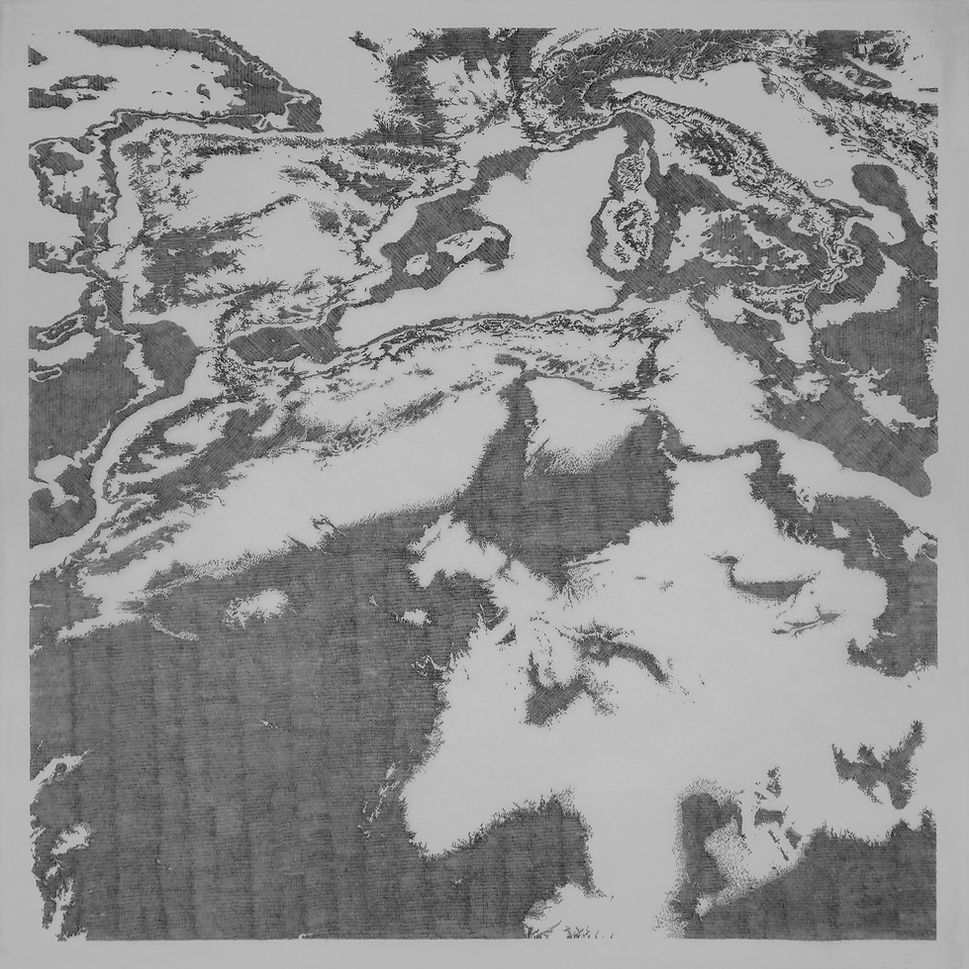SOLATERRA is a series of works and part of a project developed along with British data scientist Robin Edwards. Each work shows a different part of the Earth's crust. By means of minute hatching are shown 7 different levels of altitude (each level is indicated by a different hatching slant), from the highest parts of the mountains to the deepest parts of the oceans. Each work is conceived as a prayer, where each and every single sign acts as a symbol of time and space, both mentally and physically. This series of works should be perceived as something timeless, a ritual, where the process of making it is undoubtedly the main part.
The complete series aims to cover the whole world, and it will be composed of 55 works.
The natural world, on the other hand, is one of infinite varieties and complexities, a multidimensional world which contains no straight lines or completely regular shapes, where things do not happen in sequences, but all together; a world where-as modern physics tells us-even empty space is curved. It is clear that our abstract system of conceptual thinking can never describe or understand this reality completely. In thinking about the world we are faced with the same kind of problem as the cartographer who tries to cover the curved face of the Earth with a sequence of plane maps. We can only expect an approximate representation of reality from such a procedure, and all rational knowledge is therefore necessarily limited. The realm of rational knowledge is, of course, the realm of science which measures and quantifies, classifies and analyses. The limitations of any knowledge obtained by these methods have become increasingly apparent in modern science, and in particular in modern physics which has taught us, in the words of Werner Heisenberg, ‘that every word or concept, clear as it may seem to be, has only a limited range of applicability.” For most of us, it is very difficult to be constantly aware of the limitations and of the relativity of conceptual knowledge. Because our representation of reality is so much easier to grasp than reality itself, we tend to confuse the two and to take our concepts and symbols for reality. It is one of the main aims of Eastern mysticism to rid us of this confusion. Zen Buddhists say that a finger is needed to point at the moon, but that we should not trouble ourselves with the finger once the moon is recognized; the Taoist sage Chuang Tzu wrote: "Fishing baskets are employed to catch fish; but when the fish are got, the men forget the baskets; snares are employed to catch hares; but when the hares are got, men forget the snares. Words are employed to convey ideas; but when the ideas are grasped, men forget the words." In the West, the semanticist Alfred Korzybski made exactly the same point with his powerful slogan, ‘The map is not the territory.’
Fritjof Capra, The Tao of Physics, An exploration of the parallels between modern physics and Eastern Mysticism – ed. Flamingo, London 1982.

SOLATERRA (esercizio 01) – 2018, ink on transparent paper, cm 110 x 110

SOLATERRA (esercizio 01) (detail) – 2018, ink on transparent paper, cm 110 x 110

SOLATERRA (esercizio 06) – 2018, ink on transparent paper, cm 110 x 110

SOLATERRA (esercizio 06) (detail) – 2018, ink on transparent paper, cm 110 x 110

SOLATERRA (esercizio 17) – 2018, ink on transparent paper, cm 110 x 110

SOLATERRA (esercizio 17) (detail) – 2018 ink on transparent paper, cm 110 x 110

SOLATERRA (esercizio 18) – 2018, ink on transparent paper, cm 110 x 110

SOLATERRA (esercizio 18) (detail) – 2018, ink on transparent paper, cm 110 x 110

SOLATERRA (esercizio 26) – 2018, ink on transparent paper, cm 110 x 110

SOLATERRA (esercizio 26) (detail) – 2018, ink on transparent paper, cm 110 x 110

